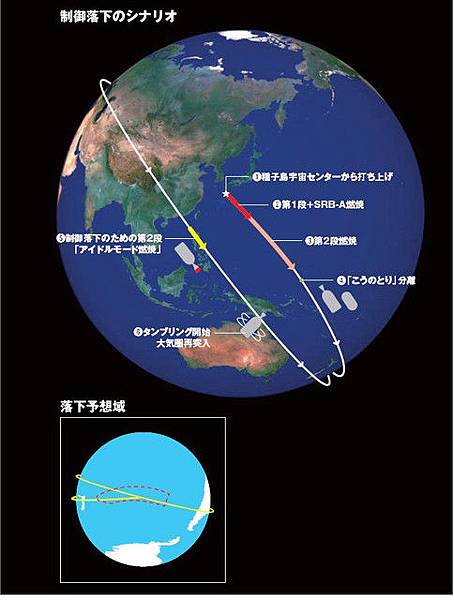控制落下 ( re-entry ) 像極了部分軌道爆擊系統(FOBS)
Ballistic missiles are slower than artificial satellites (they still reach more than 6 kilometers per second from 4.5 km per second) and fly the shortest distance from the launch point to the target, so if you capture them with radar, the orbits are determined in a short time by the computer, Evacuation of the residents is possible as the falling point is known.
In FOBS, it is injected into the orbit circling the Earth at the same speed as the artificial satellite at about 7.9 km / sec. Its altitude is about 100 km to 150 km, which is much lower than the peak altitude of intercontinental ballistic missiles, so it is difficult to detect early even in a large-scale radar network. Moreover, the shortest distance around the North Pole is irrelevant in order to take orbit around the earth, so I do not know in advance in what direction it will fly from. Soviet prime minister Nikita Khrushchev in the 1960s gave a lively voice saying "I can attack the United States across the Antarctica", but in fact it is possible, and if I take such a path, the US side can not sense the attack, It will be hit hard.
In this way, FOBS is advantageous as a strategic weapon, but there are also many disadvantageous parts. Unlike ballistic missiles, this method requires that the warhead be placed "on a satellite orbit and then decelerated from its orbital speed and fall." It requires a higher speed than the ballistic missile, the rocket becomes a large, high output one, while the nuclear warhead to be loaded must be lightened (low power) on the one hand. Besides, unlike ballistic missile warheads that are only projected towards the target, the FOBS warhead has to slow down by performing reverse injection to reenter the atmosphere, and the equipment required for it is weighed , The power of nuclear warheads decreases more and more. In addition, the timing of deceleration by reverse injection is difficult and the hit accuracy drops greatly (= CEP is large). In addition, FOBS could finish the ground deployed radar network, but could not hide from orbiting infrared early warning satellites, the United States was able to know the launch of R-36-O early . There were many such difficulties, and due to the conclusion of the second strategic weapons restriction negotiations, it was abolished in a short period of time.
In FOBS, it is injected into the orbit circling the Earth at the same speed as the artificial satellite at about 7.9 km / sec. Its altitude is about 100 km to 150 km, which is much lower than the peak altitude of intercontinental ballistic missiles, so it is difficult to detect early even in a large-scale radar network. Moreover, the shortest distance around the North Pole is irrelevant in order to take orbit around the earth, so I do not know in advance in what direction it will fly from. Soviet prime minister Nikita Khrushchev in the 1960s gave a lively voice saying "I can attack the United States across the Antarctica", but in fact it is possible, and if I take such a path, the US side can not sense the attack, It will be hit hard.
In this way, FOBS is advantageous as a strategic weapon, but there are also many disadvantageous parts. Unlike ballistic missiles, this method requires that the warhead be placed "on a satellite orbit and then decelerated from its orbital speed and fall." It requires a higher speed than the ballistic missile, the rocket becomes a large, high output one, while the nuclear warhead to be loaded must be lightened (low power) on the one hand. Besides, unlike ballistic missile warheads that are only projected towards the target, the FOBS warhead has to slow down by performing reverse injection to reenter the atmosphere, and the equipment required for it is weighed , The power of nuclear warheads decreases more and more. In addition, the timing of deceleration by reverse injection is difficult and the hit accuracy drops greatly (= CEP is large). In addition, FOBS could finish the ground deployed radar network, but could not hide from orbiting infrared early warning satellites, the United States was able to know the launch of R-36-O early . There were many such difficulties, and due to the conclusion of the second strategic weapons restriction negotiations, it was abolished in a short period of time.






